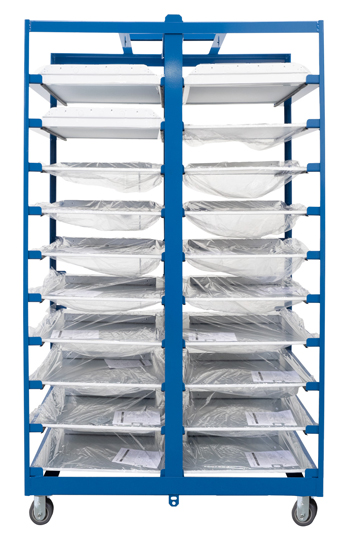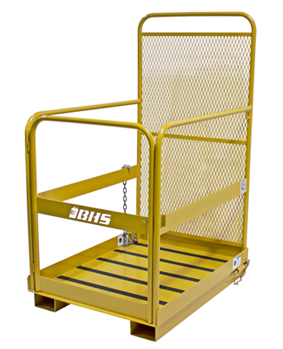We use cookies to make your experience better. To comply with the new e-Privacy directive, we need to ask for your consent to set the cookies. Learn more.
Safety and Ergonomics for Commercial Lighting Installation Jobs
Commercial lighting installation is a major part of any nonresidential construction project. It is important to recognize and address the safety hazards associated with the job — especially since these risks are intensified by strong demand for lighting in the commercial sector.
The latest Commercial Buildings Energy Consumption Survey from the U.S. Energy Information Administration (EIA) provides a snapshot of the sheer scope of lighting demand in the U.S. According to EIA research, there were 87,093 million square feet of commercial building stock in 2012. Nearly 69,000 million square feet of that space, or 82 percent of the whole, was lighted.
Most of that illumination came from standard fluorescent light fixtures. A full 93 percent of commercial buildings with illumination used standard fluorescent lights; they lit 78 percent of illuminated commercial floor space in the country in 2012.
So what does this mean for construction electricians and others tasked with installing all those fluorescent light fixtures? Without adequate ergonomic equipment and training, it means more injuries, more days away from work, and potentially life-changing impairments.
Here are some of the key safety risks surrounding the installation of standard fluorescent light fixtures, along with expert tips on how to avoid common hazards:
-
Handling Light Fixtures
Lighting installation in commercial settings tends to require a large number of traditional fluorescent light fixtures, which carry a range of ergonomic risks for electricians. Fixtures usually aren't too heavy, but they are awkward, fragile, and full of sharp edges.

Even worse, handling a large number of fixtures requires repetitive motions, which the Occupational Safety and Health Administration (OSHA) lists as a risk-factor for musculoskeletal injury. This hazard is increased when fixtures arrive at the job site in full cardboard packaging, which is necessary when transporting unsecured fixtures to prevent product loss.
The quickest solution to the ergonomics risks of managing fixtures — as well as productivity losses associated with excessive cardboard packaging — is to use Light Fixture Carts to store and move these items during installation. Light Fixture Carts hold up to 40 fixtures (depending on design) in separated and stabilized shelves. This prevents the units from knocking into one another during movement, limiting product loss.
These carts allow staff to move bulk loads of fixtures throughout a job site without repetitive motion, awkward postures, or multiple trips back and forth. Their slim profile allows them to fit through standard doorways to reach virtually any point of installation. This is another case where the right tool is necessary to do the job safely.
-
Ladders, Aerial Lifts, and Fall Risks
OSHA places falls at the top of the construction industry's "Fatal Four" list. In 2016, nearly 40 percent of the workplace deaths in construction were associated with falling.
Of all the structures workers in these cases fell from between 2011 and 2016, ladders were most common. In that timespan, 836 workers lost their lives to falls from ladders.
Which profession uses ladders the most? Next to firefighters, the answer is electricians, according to the Bureau of Labor Statistics' 2017 investigation. Together, these statistics tell us that installing light fixtures at the top of a ladder can be a risky task.

One option to reduce the risk is to avoid ladders altogether; aerial lifts designed for personnel may offer more safety features than a simple ladder. Forklift Work Platforms, for instance, surround users on all sides with guard railings and toe kicks, and with multiple points for attaching safety harnesses.
If construction electricians do use ladders, though, train them to avoid carrying fixtures while climbing. In rooms with low-enough ceilings, they can safely pull the fixture from the top shelves of the 6.6-foot Light Fixture Cart once they've ascended the ladder. Otherwise, have a second worker hand fixtures up, or use a rope to pull them to height. The point is, without both hands to grasp the rungs, workers increase their fall risk.
Ensure that all staff involved in installing fixtures use fiberglass ladders (never aluminum), place ladders on a flat, stable surface, and avoid leaning away from the rails. -
Awkward Work Postures
Installing fixtures can become a literal pain in the neck.
One systematic review of studies on the association between work-related motions and neck injuries revealed strong evidence of this link for the following physical incidents
- Manual material handling
- Rotating the torso while working
- Keeping hands elevated above the shoulder to complete tasks
- Awkward postures
All of these are associated with installing light fixtures. So how can construction electricians avoid these hazards?
Writing in the trade publication Electrical Construction and Maintenance, electrical consultant Mark Lamendola offers a novel solution: belay glasses.
These reflective lenses were developed by a mountain climber to remedy the neck strain that comes with belaying, or managing rope from the ground for a fellow-climber. They use prisms that allow wearers to see upwards without tilting their heads back.
"If your work involves much looking up, get these glasses," wrote Lamendola.
Otherwise, the best way to prevent neck, shoulder, and back pain is to position ladders to minimize awkward postures and an upward-tilting gaze. Keeping work directly in front of the worker's field of vision will limit strain on the neck and shoulders, helping to prevent the unfortunately common development of musculoskeletal disorders.
-
Dropped Tools and Components
More than 9 percent of the construction workers who lost their lives on the job were fatally struck by objects, placing these deaths second on OSHA's "Fatal Four" hazards in the construction industry. There's no quicker way to be struck by an object than to be in the wrong place when an elevated worker drops a tool.
According to a 2016 article in trade publication EHS Today, OSHA records more than 50,000 cases of workers being struck by falling objects every year. Luckily, there are some simple precautions construction electricians can take to prevent these incidents while installing light fixtures:
- When using personnel lifts or scaffolding, make sure they have toe boards to keep tools from going over the edge. Forklift Work Platforms from BHS are manufactured with 4-inch-high toe guards to satisfy this precaution.
- Follow OSHA requirements regarding personal protective equipment (PPE). Under the OSHA rules for the construction industry, standard 501(c) requires employers to enforce a hard-hat policy wherever the potential for falling objects is present.
- In addition to the hard-hat proviso, OSHA requires employers to choose betweens toe boards (as we've mentioned), screens, or guardrails to keep objects from falling from above. Alternately, employers can install a canopy or completely barricade the area beneath the work space. Since these solutions are unlikely for a lighting installation, most electricians will use toe boards and/or secure tools per an OSHA Construction eTool.
It is interesting to note that OSHA regulations address falling objects in the same section that covers fall protections for workers themselves; clearly, working at height is a unique, multi-faceted risk.
Injury-Free Commercial Lighting Installation
Workers in the electrical industry have enough to worry about preventing shocks and other dangerous electrical incidents. It can be difficult to spare the mental energy to address less-obvious threats, like musculoskeletal disorders that develop over years or a slippery rung on a ladder.
But every investment in safety pays off with the first averted injury. Because construction electricians face distinct risks in lighting installation, it is always worth an employer's time to develop an up-to-date safety policy for this and other tasks.
The tips above make a great starting point. With the right equipment and well-designed safety protocols, electricians can complete every commercial lighting installation job safely and in record time.
References:
"29 CFR 1926.501 — Fall Protection." OSHA. Occupational Safety and Health Administration, U.S. Department of Labor, n.d. Web. 18 June 2018.
Caldwell, Mark. "The Sky Isn't Falling (And Your Tools Shouldn't Either)." EHSToday. Informa, 1 Mar. 2016. Web. 18 June 2018.
"Climbing the ladder (or rope or scaffold) on the job in 2017." BLS. Bureau of Labor Statistics, U.S. Department of Labor, 7 Mar. 2018. Web. 14 June 2018.
"Commercial Buildings Energy Consumption Survey (CBECS)." EIA. U.S. Energy Information Administration, 17 May 2017. Web. 14 June 2018.
"Commonly Used Statistics." OSHA. Occupational Safety and Health Administration, U.S. Department of Labor, n.d. Web. 14 June 2018.
"Construction eTool: Struck-By." OSHA. Occupational Safety and Health Administration, U.S. Department of Labor, n.d. Web. 18 June 2018.
"Ergonomics." OSHA. Occupational Safety and Health Administration, U.S. Department of Labor, n.d. Web. 14 June 2018.
"Ergonomics eTool: Solutions for Electrical Contractors." OSHA. Occupational Safety and Health Administration, U.S. Department of Labor, n.d. Web. 14 June 2018.
"Fatal work-related falls to a lower level increased 26 percent from 2011 to 2016." BLS. Bureau of Labor Statistics, U.S. Department of Labor, 7 May 2018. Web. 14 June 2018.
Lamendola, Mark. "How to Ensure Safe Ceiling Work." ECMWeb. Informa, 17 Apr. 2018. Web. 14 June 2018.
Mayer, Julia, et al. "Longitudinal Evidence for the Association between Work-Related Physical Exposures and Neck And/Or Shoulder Complaints: A Systematic Review." International Archives of Occupational and Environmental Health, vol. 85, no. 6, Aug. 2012, pp. 587-603. EBSCOhost, doi:10.1007/s00420-011-0701-0.

